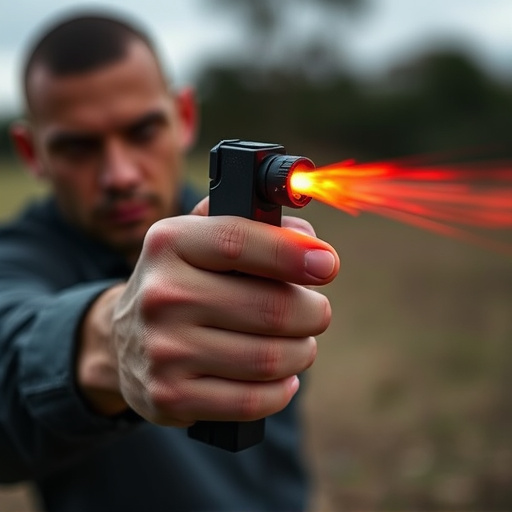To legally carry pepper spray, understand that local laws govern its possession and use. Research specific regulations regarding type, amount, permitted uses, and carrying locations within your jurisdiction. Comply with requirements such as permits or registration, restrictions on carrying, and consequences of misuse. Ensure safety by undergoing rigorous training, securing storage, inspecting for damage, and only using it as a last resort for self-defense or controlling dangerous situations.
“Uncovering the power of pepper spray as a critical tool in law enforcement, this article navigates its strategic deployment and legal considerations. From understanding the chemical’s impact to mastering safe handling, we explore the essential steps for officers aiming to legally carry and effectively utilize pepper spray. By delving into the underlying regulations, preparing for compliance, and adopting responsible use guidelines, law enforcement agencies can harness this potent tool while upholding safety measures.”
- Understanding Pepper Spray as a Law Enforcement Tool
- Legal Framework for Carrying Pepper Spray
- Preparing to Legally Carry Pepper Spray
- Safety Measures and Responsible Use Guidelines
Understanding Pepper Spray as a Law Enforcement Tool
Pepper spray, also known as oleoresin capsicum (OC) spray, is a non-lethal weapon widely used by law enforcement agencies worldwide. It utilizes a chemical agent derived from chili peppers to incapacitate individuals temporarily, allowing officers to gain control of a situation and ensure public safety. This versatile tool plays a crucial role in crowd control, subject restraint, and self-defense for police personnel during high-risk operations.
To legally carry pepper spray as a law enforcement officer, strict protocols and regulations must be followed. Officers typically undergo specialized training to learn how to deploy the spray effectively while minimizing harm. The type of pepper spray used is carefully selected based on factors like potency, range, and duration of effects, ensuring its compliance with local laws and standards. Proper storage and handling procedures are also essential to maintain the integrity and effectiveness of the spray.
Legal Framework for Carrying Pepper Spray
The legal framework for carrying pepper spray varies significantly across jurisdictions, so it’s crucial to understand the specific regulations in your area. In many countries and states, pepper spray is classified as a weapon, subject to strict controls. To legally carry pepper spray, individuals typically need to obtain a permit or license from relevant law enforcement agencies or local authorities. This process often involves background checks, training requirements, and proof of proficiency in the safe handling of such devices.
How to Legally Carry Pepper Spray involves adhering to these legal requirements. It’s essential to research and comply with local laws, which may include restrictions on the type and amount of pepper spray allowed, permitted uses, and where it can be carried (e.g., in a vehicle or public spaces). Some jurisdictions might allow its use only for self-defense, while others may extend its permissible uses to crowd control or other specific scenarios. Regularly updating knowledge about these laws is vital to ensure compliance and avoid legal consequences.
Preparing to Legally Carry Pepper Spray
Before considering how to legally carry pepper spray, it’s crucial to understand the applicable laws in your jurisdiction. Each country and state has different regulations regarding the possession and use of pepper spray by civilians. These laws can vary based on the quantity, strength, and purpose for which the spray is intended. It’s essential to research and comply with local legislation to avoid legal repercussions.
To legally carry pepper spray, start by checking your area’s specific rules. Some places may require permits or registration for certain types of self-defense tools, including pepper spray. Ensure you’re familiar with any restrictions on where and when you can have it on your person, such as in public places or while in a vehicle. Additionally, understand the consequences of misuse or unauthorized possession to make informed decisions about its acquisition and handling.
Safety Measures and Responsible Use Guidelines
Pepper spray, a powerful non-lethal weapon, is only legal for carrying and use by authorized individuals, typically law enforcement officers and in some cases, civilians under specific circumstances. Understanding how to legally carry pepper spray involves adhering to strict safety measures and responsible use guidelines.
First and foremost, proper training is paramount. Users must be educated on the spray’s effects, safe handling procedures, and legal restrictions. It’s crucial to familiarize yourself with local laws and regulations governing pepper spray ownership and deployment, as these vary significantly from one jurisdiction to another. Responsible use includes ensuring that the spray is only employed as a last resort when necessary for self-defense or to control dangerous situations. Safety measures extend to proper storage, keeping the spray out of reach of children and unauthorized individuals, and regularly inspecting the device for any signs of damage or malfunction.
Pepper spray is a powerful tool when used responsibly and within legal boundaries. Understanding the legal framework, safety measures, and responsible use guidelines is crucial for law enforcement officers looking to deploy this weapon effectively. By following these steps and staying informed about local regulations, officers can ensure they are using pepper spray appropriately and legally, contributing to public safety without compromising their own well-being or facing legal repercussions. Knowing how to legally carry pepper spray is essential for maintaining order and protecting communities.
